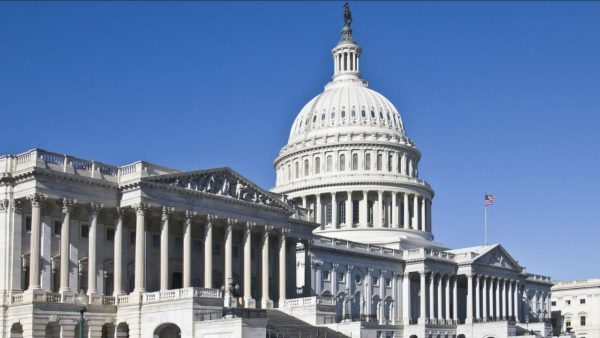WASHINGTON—A bill intended to save the nation’s struggling multiemployer pension funds would cost far less than previously thought, according to a Congressional Budget Office estimate its sponsors released Sept. 12.

The CBO projected that the Butch Lewis Act, which would set up a Treasury Department agency to make 30-year low-interest loans to the 150 to 200 multiemployer funds most likely to become insolvent within 20 years, would cost $34 billion from 2019 through 2028. That’s “much less than earlier reports” that it would cost as much as $100 billion, Sen. Sherrod Brown (D-Ohio) and Rep. Richard Neal (D-Mass.) said in a joint statement, and less than half of what the federal Pension Benefit Guarantee Corporation, the agency that insures multiemployer plans, has estimated it would have to pay out if the plans went under.
The $34 billion figure is “more in line with what our actuaries projected,” a Teamsters Union spokesperson told LaborPress. “We’re hoping the CBO score will move some needles on the Joint Select Committee.”
The Joint Select Committee on Solvency of Multiemployer Pension Plans, formed as part of a compromise after Republicans blocked adding the Butch Lewis Act to the federal budget for fiscal 2019, is supposed to produce legislation to address the problem by Nov. 30. Cochaired by Brown and Sen. Orrin Hatch (R-Utah), its 16 members are evenly divided between Democrats and Republicans, House and Senate members. They also include Neal, ranking Democrat on the House Ways and Means Committee, and Rep. Virginia Foxx (R-N.C.), chair of the House Committee on Education and the Workforce.
Support for the Butch Lewis Act and its House companion, the Rehabilitation for Multiemployer Pensions Act, is highly partisan. All 22 cosponsors in the Senate are Democrats. In the House, 156 of the 168 are Democrats, and eight of the 12 Republican cosponsors are from New York, New Jersey, and Pennsylvania.
A spokesperson for Sen. Hatch told Bloomberg Law that he has neither seen the bill’s current text, nor obtained any formal estimate from the CBO. Rep. Foxx’s office told LaborPress they had no announcement on it.
About 15% of the 10 million American workers and retirees enrolled in multiemployer plans are in funds considered endangered. The Teamsters’ Central States Pension Fund is the largest of them, with 400,000 active workers and retirees participating. It is one of three large plans that have notified the Department of Labor that they are likely to become insolvent within seven years. The 35,000-member New York State Teamsters Conference Pension and Retirement Fund, which covers members of Local 812 on Long Island and Local 560 in Union City, N.J. has already cut benefits to avoid bankruptcy.
About 15% of the 10 million American workers and retirees enrolled in multiemployer plans are in funds considered endangered.
If the Central States fund goes under, the Teamsters estimate it would cost the nation $2.8 billion a year in retirement income. Most participants are in the upper Midwest: Ohio has about 44,000, only 6,000 of them working, with 24,000 retirees who receive $364 million a year in pensions, about $15,000 each on average.
In August, Alex Brill, chief economist and policy advisor for the House Committee on Ways and Means from 2002 to 2007, projected that if the Central States fund went insolvent in 2025, it would cost the nation more than 55,000 jobs, more than $5 billion in lost economic activity, and more than $1.6 billion in tax revenue.
The Teamsters funds fell into trouble because the decline of union trucking after the industry was deregulated slashed the number of active workers paying into the plans. The United Mine Workers of America fund is in a similar state because of the decline of coal mining. The Great Recession of 2008 also decimated many funds’ investments.
The PBGC’s Multiemployer Program already has a $65 billion deficit, director Thomas Reeder told the House Committee on Education and the Workforce in May—more than 90% of it projected as financial assistance to 47 plans expected to exhaust their assets within 10 years. He said it was “more likely than not” that the program would run out of money in 2025, with about $78 billion in liabilities.
If a pension plan goes bankrupt and the PBGC pays benefits, the maximum guaranteed benefit for a retiree with 30 years of service is $12,870 a year—an amount that has not increased since 2001, Reeder added.
When the PBGC began aiding an insolvent Long Island Teamsters multiemployer plan, Road Carriers Local 707 Pension Fund, in early 2017, 42% of its retirees and beneficiaries had their benefits reduced by more than half. The fund had promised it would pay them an average of about $1,300 a month, but only 7% got that much. The average guaranteed benefit, based on limits set in federal law, was $570.
The Butch Lewis Act would enable these funds to pay full benefits to current retirees, with the loans intended to tide them over until the balance between workers and retirees is restored.
“We feel it’s the best solution,” the Teamsters spokesperson said.



